An atrial fibrillation-associated regulatory region modulates cardiac Tbx5 levels and arrhythmia susceptibility
- PMID: 36715501
- PMCID: PMC9928424
- DOI: 10.7554/eLife.80317
An atrial fibrillation-associated regulatory region modulates cardiac Tbx5 levels and arrhythmia susceptibility
Abstract
Heart development and rhythm control are highly Tbx5 dosage-sensitive. TBX5 haploinsufficiency causes congenital conduction disorders, whereas increased expression levels of TBX5 in human heart samples has been associated with atrial fibrillation (AF). We deleted the conserved mouse orthologues of two independent AF-associated genomic regions in the Tbx5 locus, one intronic (RE(int)) and one downstream (RE(down)) of Tbx5. In both lines, we observed a modest (30%) increase of Tbx5 in the postnatal atria. To gain insight into the effects of slight dosage increase in vivo, we investigated the atrial transcriptional, epigenetic and electrophysiological properties of both lines. Increased atrial Tbx5 expression was associated with induction of genes involved in development, ion transport and conduction, with increased susceptibility to atrial arrhythmias, and increased action potential duration of atrial cardiomyocytes. We identified an AF-associated variant in the human RE(int) that increases its transcriptional activity. Expression of the AF-associated transcription factor Prrx1 was induced in Tbx5RE(int)KO cardiomyocytes. We found that some of the transcriptional and functional changes in the atria caused by increased Tbx5 expression were normalized when reducing cardiac Prrx1 expression in Tbx5RE(int)KO mice, indicating an interaction between these two AF genes. We conclude that modest increases in expression of dose-dependent transcription factors, caused by common regulatory variants, significantly impact on the cardiac gene regulatory network and disease susceptibility.
Keywords: arrhythmias; atrial fibrillation; chromosomes; epigenetics; gene expression; genetic variation; genetically altered; genetics; genomics; mouse; regulation; transgenic models.
© 2023, Bosada et al.
Conflict of interest statement
FB, Kv, AG, MR, JU, AV, BB, VC No competing interests declared
Figures

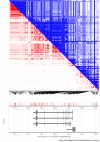


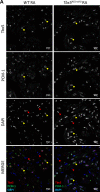

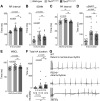
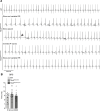


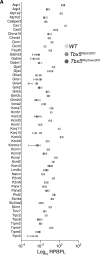
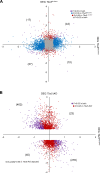




Similar articles
-
Patient-Specific TBX5-G125R Variant Induces Profound Transcriptional Deregulation and Atrial Dysfunction.Circulation. 2022 Feb 22;145(8):606-619. doi: 10.1161/CIRCULATIONAHA.121.054347. Epub 2022 Feb 3. Circulation. 2022. PMID: 35113653 Free PMC article.
-
Pitx2 modulates a Tbx5-dependent gene regulatory network to maintain atrial rhythm.Sci Transl Med. 2016 Aug 31;8(354):354ra115. doi: 10.1126/scitranslmed.aaf4891. Sci Transl Med. 2016. PMID: 27582060 Free PMC article.
-
A Genomic Link From Heart Failure to Atrial Fibrillation Risk: FOG2 Modulates a TBX5/GATA4-Dependent Atrial Gene Regulatory Network.Circulation. 2024 Apr 9;149(15):1205-1230. doi: 10.1161/CIRCULATIONAHA.123.066804. Epub 2024 Jan 8. Circulation. 2024. PMID: 38189150 Free PMC article.
-
Epigenetic and Transcriptional Networks Underlying Atrial Fibrillation.Circ Res. 2020 Jun 19;127(1):34-50. doi: 10.1161/CIRCRESAHA.120.316574. Epub 2020 Jun 18. Circ Res. 2020. PMID: 32717170 Free PMC article. Review.
-
Regulatory role of cardiomyocyte metabolism via AMPK activation in modulating atrial structural, contractile, and electrical properties following atrial fibrillation.Can J Physiol Pharmacol. 2021 Jan;99(1):36-41. doi: 10.1139/cjpp-2020-0313. Epub 2020 Oct 13. Can J Physiol Pharmacol. 2021. PMID: 33049144 Review.
Cited by
-
Tbx5 maintains atrial identity in post-natal cardiomyocytes by regulating an atrial-specific enhancer network.Nat Cardiovasc Res. 2023 Oct;2(10):881-898. doi: 10.1038/s44161-023-00334-7. Epub 2023 Oct 12. Nat Cardiovasc Res. 2023. PMID: 38344303 Free PMC article.
-
Atrial fibrillation variant-to-gene prioritization through cross-ancestry eQTL and single-nucleus multiomic analyses.iScience. 2024 Aug 5;27(9):110660. doi: 10.1016/j.isci.2024.110660. eCollection 2024 Sep 20. iScience. 2024. PMID: 39262787 Free PMC article.
-
Overview of programmed electrical stimulation to assess atrial fibrillation susceptibility in mice.Front Physiol. 2023 Apr 11;14:1149023. doi: 10.3389/fphys.2023.1149023. eCollection 2023. Front Physiol. 2023. PMID: 37113690 Free PMC article. Review.
-
Role of Genetic Variation in Transcriptional Regulatory Elements in Heart Rhythm.Cells. 2023 Dec 19;13(1):4. doi: 10.3390/cells13010004. Cells. 2023. PMID: 38201209 Free PMC article. Review.
-
Beyond genomic studies of congenital heart defects through systematic modelling and phenotyping.Dis Model Mech. 2024 Nov 1;17(11):dmm050913. doi: 10.1242/dmm.050913. Epub 2024 Nov 22. Dis Model Mech. 2024. PMID: 39575509 Free PMC article.
References
-
- Bamshad M, Lin RC, Law DJ, Watkins WC, Krakowiak PA, Moore ME, Franceschini P, Lala R, Holmes LB, Gebuhr TC, Bruneau BG, Schinzel A, Seidman JG, Seidman CE, Jorde LB. Mutations in human TBX3 alter limb, apocrine and genital development in Ulnar-Mammary syndrome. Nature Genetics. 1997;16:311–315. doi: 10.1038/ng0797-311. - DOI - PubMed
-
- Basson CT, Bachinsky DR, Lin RC, Levi T, Elkins JA, Soults J, Grayzel D, Kroumpouzou E, Traill TA, Leblanc-Straceski J, Renault B, Kucherlapati R, Seidman JG, Seidman CE. Mutations in human Tbx5 [ corrected ] cause limb and cardiac malformation in Holt-Oram syndrome. Nature Genetics. 1997;15:30–35. doi: 10.1038/ng0197-30. - DOI - PubMed
Publication types
MeSH terms
Substances
Associated data
- Actions
- Actions
Grants and funding
LinkOut - more resources
Full Text Sources
Medical
Molecular Biology Databases
Research Materials

